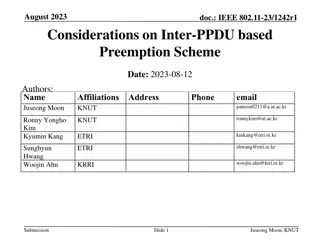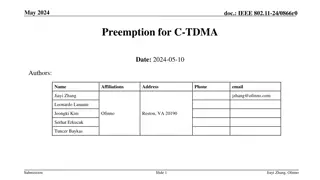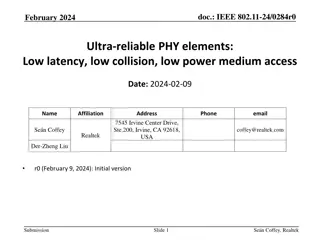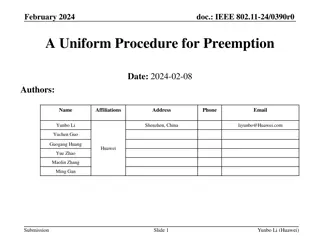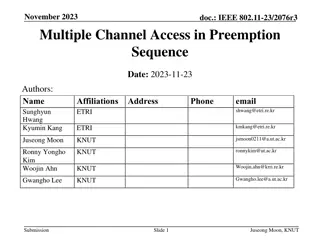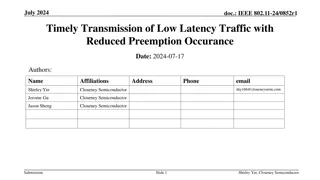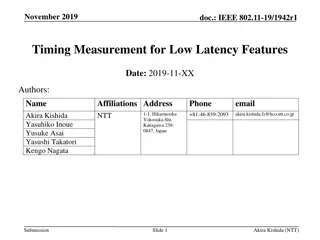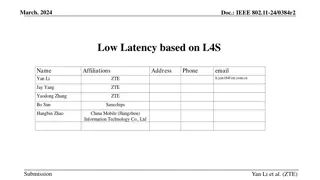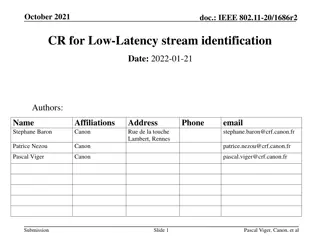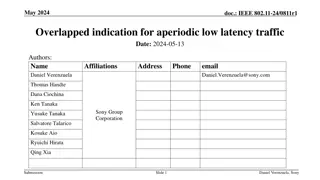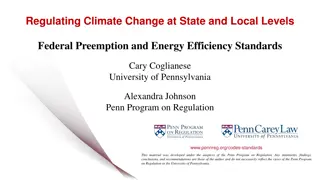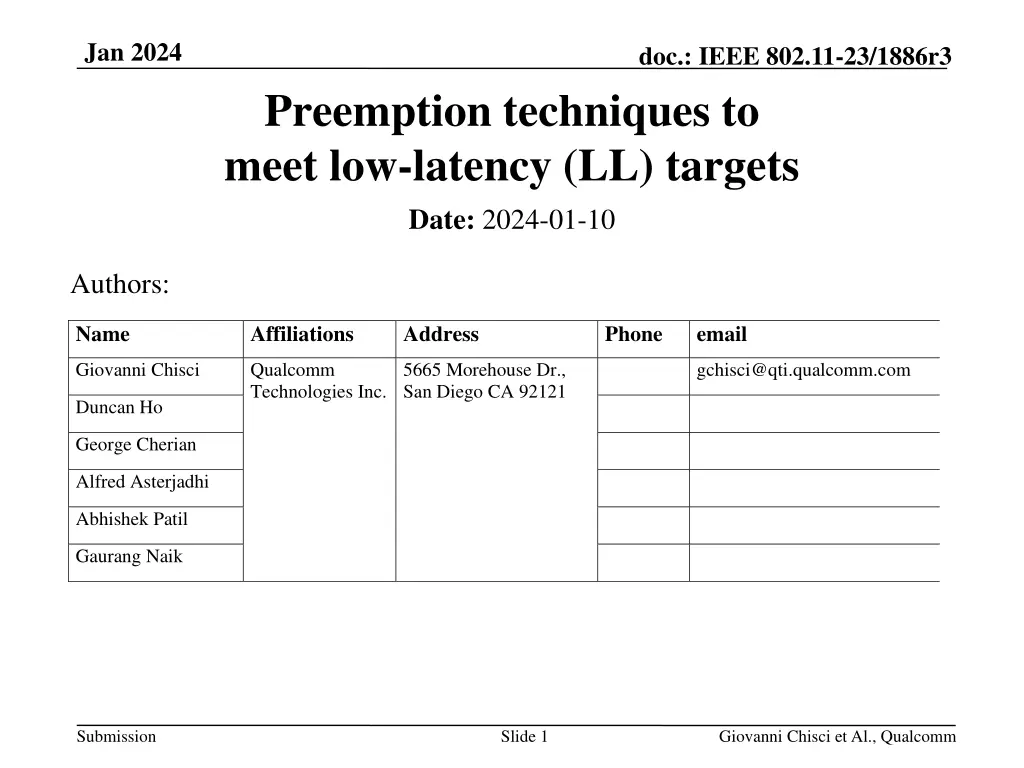
Preemption Techniques for Low-Latency Targets in IEEE 802.11-23
Explore preemption techniques to meet low-latency targets in IEEE 802.11-23, focusing on handling aperiodic latency-sensitive traffic. The document addresses cases for preempting DL and UL TXOP to optimize latency-sensitive traffic delivery, providing solutions for DL and UL traffic scenarios during communication.
Download Presentation

Please find below an Image/Link to download the presentation.
The content on the website is provided AS IS for your information and personal use only. It may not be sold, licensed, or shared on other websites without obtaining consent from the author. If you encounter any issues during the download, it is possible that the publisher has removed the file from their server.
You are allowed to download the files provided on this website for personal or commercial use, subject to the condition that they are used lawfully. All files are the property of their respective owners.
The content on the website is provided AS IS for your information and personal use only. It may not be sold, licensed, or shared on other websites without obtaining consent from the author.
E N D
Presentation Transcript
Jan 2024 doc.: IEEE 802.11-23/1886r3 Preemption techniques to meet low-latency (LL) targets Date: 2024-01-10 Authors: Name Affiliations Address Phone email Giovanni Chisci Qualcomm Technologies Inc. 5665 Morehouse Dr., San Diego CA 92121 gchisci@qti.qualcomm.com Duncan Ho George Cherian Alfred Asterjadhi Abhishek Patil Gaurang Naik Submission Slide 1 Giovanni Chisci et Al., Qualcomm
Jan 2024 doc.: IEEE 802.11-23/1886r3 Background & Problem Statement One of the goals of UHR is to improve latency for latency sensitive traffic Latency sensitive traffic can be classified into two groups: Periodic and aperiodic traffic Techniques such as Coordinated AP/Medium Access could handle the periodic latency sensitive traffic The scope of this document is to consider aperiodic latency sensitive traffic In the baseline, when a new latency sensitive packet arrives, the AP/non- AP STA will need to wait until the end of the ongoing TXOP (see [1-4]) This document proposes mechanisms for the following two cases: Case 1: Preempt the DL TXOP to send UL latency sensitive traffic Case 2: Preempt the UL TXOP to send DL latency sensitive traffic Submission Slide 2 Giovanni Chisci et Al., Qualcomm
Jan 2024 doc.: IEEE 802.11-23/1886r3 Case 1: Preempt DL TXOP to Send UL DL LL traffic arrived during a DL TXOP: Wait until ongoing PPDU is completed New DL Low-lat Packet arrived AP Long DL PPDU Low Lat PPDU ack ack STA time Low Lat TXOP TXOP UL LL traffic arrived during a DL TXOP: Long DL PPDU AP ack time TXOP New UL Low-lat Packet arrived Pre-11bn: Wait until ongoing DL TXOP is completed Low Lat PPDU STA ack time Low Lat TXOP TXOP 11bn need to address this issue (main focus in these slides) Submission Slide 3 Giovanni Chisci et Al., Qualcomm
Jan 2024 Solution for DL LL traffic arriving during a DL TXOP doc.: IEEE 802.11-23/1886r3 New DL Low-lat Packet arrived 11bn TXOP DL Pre-emption Long DL PPDU is split into smaller PPDUs AP Low Lat PPDU DL PPDU 1 DL PPDU 2 ack ack ack time STA(s) Simple MAC solution using baseline mechanisms. Covers most of the cases. Submission Slide 4 Giovanni Chisci et Al., Qualcomm
Jan 2024 doc.: IEEE 802.11-23/1886r3 Solution for UL LL traffic arriving during a DL TXOP Preemption using baseline mechanisms Long DL PPDU is split into smaller PPDUs DL PPDU 1 + NFRP AP Trigger to LL DL PPDU 2+acks NFRP/NFR based preemption ack time TB-PPDU: UL LL data TB-PPDU: UL LL data ack STA NFR TB-PPDU: UL LL data Long DL PPDU is split into smaller PPDUs DL PPDU 1 + BSRP AP Trigger to LL DL PPDU 2+acks BSRP/BSR based preemption ack BSR time TB-PPDU: UL LL data TB-PPDU: UL LL data ack STA TB-PPDU: UL LL data Long DL PPDU is split into smaller PPDUs DL PPDU 1 + UORA TF DL PPDU 2 + acks AP UORA based preemption ack time ack STA UORA-1 UORA-2 UORA-n Submission Slide 5 Giovanni Chisci et Al., Qualcomm
Jan 2024 doc.: IEEE 802.11-23/1886r3 Solution for UL LL traffic arriving during a DL TXOP EDCA-based Preemption mechanisms AP grants LL devices an opportunity to contend within its DL TXOP Handles the cases when AP doesn t have the knowledge of which clients has LL traffic Advantages of allowing EDCA explicitly by the AP Enables the AP to inject DL LL traffic that arrives during a DL TXOP AP s announcement can be heard by all STAs in the BSS Reduces contention with DL access for LL data AP sends a preemption enabled (PR) indication to LL clients and will perform the next DL PPDU transmission PIFS after the BA in case no associated STA sends a preemption indication frame (PRI) could be sent in a PHY header of DL PPDU or BA sent by the AP AP includes the granted duration limit for the EDCA LL transmissions Clients can send a PRI within PIFS (e.g. SIFS after the BA) and then start contending by ignoring the NAV set by the AP in previous frames (e.g., AP uses Multiple protection settings) Client use only a random backoff count with TBD max Time slots Submission Slide 6 Giovanni Chisci et Al., Qualcomm
Jan 2024 Solution for UL LL traffic arriving during a DL TXOP doc.: IEEE 802.11-23/1886r3 EDCA-based Preemption mechanisms (Cont d) AP includes PR enabled PIFS PIFS PIFS DL PPDU 2 Long DL PPDU is split into smaller PPDUs DL PPDU 1 +PR enabled (SU PPDU) (SU PPDU) ack ack DL PPDU 2 (SU PPDU) AP UL LL data ack PRI UL LL data PRI ack time STA SIFS SIFS If there is no PRI, and if the TXOP is not exhausted, then AP access PIFS after Other LL STAs will send PRI, a SIFS later after Ack LL STAs send Preemption Traffic IndicationPRI), SIFS after ack Note: PRI could be a CTS frame LL STAs contend to send LL data New DL Low-lat (LL) Packet arrived SIFS PIFS AP includes PR enabled Long DL PPDU is split into smaller PPDUs DL PPDU 1 +PR enabled (SU PPDU) PIFS (TB PPDU) (SU PPDU) ack ack DL LL PPDU 2 AP ack PRI UL LL data PRI UL LL data ack time STA SIFS When DL LL Packet Arrives, AP may indicate the PR is disabled so that it deliver the LL DL packet LL STAs contend to send LL data The purpose of the PR enabled/PRI is not to identify the LL device but to see if there is any such device that have pending LL data within a PIFS duration Submission Slide 7 Giovanni Chisci et Al., Qualcomm
Jan 2024 Solution for UL LL traffic arriving during a DL TXOP doc.: IEEE 802.11-23/1886r3 EDCA-based Preemption mechanisms (Cont d) PIFS Long DL PPDU is split into smaller PPDUs DL PPDU 1 +PR allowed (TB PPDU) (SU PPDU) ack ack DL PPDU 2 (SU PPDU) AP (includes Trigger) ack PRI UL LL data UL LL data ack STA time PRI If there is no PRI, and if the TXOP is not exhausted, then AP access PIFS after AP allocates one RU for all the LL clients to indicate Preemption Traffic IndicationPRI) Note: PRI could be a CTS frame Other LL STAs will send PRI, a SIFS later after Ack LL STAs contend to send LL data Alternatively, to reduce hidden node problem, the AP can allocate one RU for all the LL clients to transmit the PRI along with the BA Submission Slide 8 Giovanni Chisci et Al., Qualcomm
Jan 2024 doc.: IEEE 802.11-23/1886r3 Case 2: Preempt UL TXOP to Send DL DL LL traffic arrived during an UL TXOP: New DL Low-lat Packet arrived Low Lat PPDU AP Long UL PPDU ack STA1 time Wait until ongoing PPDU is completed 11bn need to address this issue (main focus in these slides) Submission Slide 9 Giovanni Chisci et Al., Qualcomm
Jan 2024 Solution for DL low latency traffic arriving during a UL TXOP doc.: IEEE 802.11-23/1886r3 AP takes over the rest of the TXOP if the client allows Ack+no PRI Ack+PRI DL LL data (STA 2) DL LL data (STA 1) AP ack ack UL PPDU 2 +PR allowed UL PPDU 1 +PR allowed STA1 time Long UL PPDU is split into smaller PPDUs If AP doesnt have LL DL data, then it indicates no PRI though eMBA If AP indicates PRI (through eMBA), UL STA relinquishes rest of the TXOP Client grants Low Latency clients ( PR allowed ) an opportunity for AP to take over the rest of the TXOP Submission Slide 10 Giovanni Chisci et Al., Qualcomm
Jan 2024 doc.: IEEE 802.11-23/1886r3 Summary We discussed the TXOP preemption to enhance the latency for event driven traffic use cases ([1]-[4]) The design should be simple, efficient, and scalable Both Trigger-based as well as EDCA based preemption are considered Trigger-based comes for free from previous amendment EDCA based can be used in those cases when trigger-based is not possible/practical EDCA based preemption enables TXOP preemption with SU PPDU transmissions within a PIFS duration using PR enabled/PRI This minimize the unnecessary overhead of polling the LL clients (e.g., NFRP/NFR, BSRP/BSR..) Significant gain from initial simulations Submission Slide 11 Giovanni Chisci et Al., Qualcomm
Jan 2024 doc.: IEEE 802.11-23/1886r3 References [1] 11-23/0018, Low latency support in UHR [2] 11-23/0092, Preemption [3] 11-23/798, Low latency traffic report [4] 11-23/1194, Overlapped Indication to Support Preemption Submission Slide 12 Giovanni Chisci et Al., Qualcomm
Jan 2024 doc.: IEEE 802.11-23/1886r3 SP Do you support to define a mechanism in 11bn for a TXOP holder to allow a STA associated with the TXOP holder to preempt the TXOP holder's frame exchange sequence for delivery of low latency traffic NOTE: The TXOP holder can be an AP or a non-AP STA NOTE: The policy for TXOP holder allowing preemption is TBD Submission Slide 13 Giovanni Chisci et Al., Qualcomm
Jan 2024 doc.: IEEE 802.11-23/1886r3 APPENDIX Submission Slide 14 Giovanni Chisci et Al., Qualcomm
Jan 2024 doc.: IEEE 802.11-23/1886r3 Initial Simulation Results for Case 1 Scenario, simulation setup 1 AP 5 STAs: 1 DL legacy + N Uplink Low Lat(LL) devices (N= 1, 2, 4) Non-LL STAs traffic: Full buffer (DL) between AP and Legacy clients; AC_VO LL STAs traffic: 1500 bytes every 40 ms; AC_VO LL traffic uniformly randomized within interarrival interval Preemption mode with xIFS = PIFS, AP TXOP limit = 5ms with PPDU limit = 1ms No hidden nodes No OBSS or other In-BSS loading DL client UL client AP UL client UL client UL client Submission Slide 15 Giovanni Chisci et Al., Qualcomm
Jan 2024 doc.: IEEE 802.11-23/1886r3 Initial Simulation Results (Cont d) => Significant Gain with AP permitted Low Latency EDCA Access 120 w/ TXOP Preemption (5 msecs TXOP) Legacy Long PPDU (5 msecs TXOP) 105 100 95 Percentile Latency (ms) UL/DL collision is one of the key contributors for bad latency for legacy operation 80 60 51 40 32 20 2.065 1.999 1.976 0 1 LL STA 2 LL STAs 4 LL STAs Submission Slide 16 Giovanni Chisci et Al., Qualcomm


